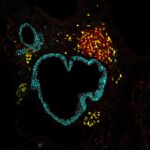
Publication: An integrative multimodal machine learning signature of primary resistance to immunotherapy in advanced non-small cell lung cancer: biomarker analysis from the PIONeeR study
Published in: 2025
Authors: Fabrice Barlesi, Florence Monville, Laurent Greillier, Natalie Ngoi, Joseph Ciccolini, Stephane Garcia, Jean-Philippe Dales, Florence Sabatier, L. Arnaud, Amélie Pouchin, Frédéric Vely, S. Bokobza, Mélanie Karlsen, Paul Dufossé, Andrea Vaglio, Mohamed Boussena, Celestin Bigarre, Mourad Hamimed, Richard Malkoun, Lamia Ghezali, Maryannick Le Ray, Marie Roumieux, Julien Mazieres, Maurice Perol, Eric Vivier, J. Fieschi-Meric, Sébastien Benzekry
Summary
Background Immune checkpoint inhibitors (ICIs) have transformed the treatment landscape for advanced non-small cell lung cancer (NSCLC), yet primary resistance remains common, with only ~50% of patients responding to first-line chemo-immunotherapy and 20–30% to monotherapy. Existing biomarkers such as PD-L1 expression and tumor mutational burden (TMB) demonstrate limited predictive accuracy, underscoring the need for more comprehensive, integrative approaches. Methods We conducted a prospective, multicenter study involving 439 patients with advanced NSCLC treated with anti-PD-(L)1 ICI across first- and later-line settings. A total of 443 pre-treatment tumor and blood-derived biomarkers—including genomic alterations, immune cell phenotypes, proteomic markers, and routine laboratory tests—were profiled. Both traditional biostatistics and a rigorously benchmarked machine learning (ML) pipeline were applied to identify predictors of primary resistance (PrR). Results Single biomarkers showed limited predictive utility, with PD-L1 (AUC 0.62), TMB (AUC 0.55), and key gene mutations (e.g., STK11, KEAP1) failing to achieve significance after multiple testing correction. A gradient boosting ML model integrating 18 features yielded a corrected AUC of 0.69 and a positive predictive value (PPV) of 60% for PrR, outperforming standard biomarkers. In first-line patients, the model achieved a PPV of 51% and NPV of 79% (baseline PrR rate: 29.9%); in subsequent-line patients, PPV reached 64% (PrR rate: 55.1%). Importantly, the signature also stratified progression-free survival (PFS): high-risk patients had a median PFS of 3.9 vs. 14.6 months in low-risk patients (HR 0.307, p < 0.0001). Features from routine blood tests—such as serum chloride, albumin, CRP, and monocyte-to-lymphocyte ratio (MLR)—accounted for half of the final model and demonstrated independent associations with both PrR and PFS (e.g., chloride: OR 0.616, AUC 0.626; HR 0.685, C-index 0.61). SHAP-based individual-level model explainability revealed heterogeneous and nonlinear biomarker contributions, including cases where high CRP, low albumin, or elevated MLR overrode favorable PD-L1 or Treg profiles. Conclusions Multimodal machine learning integration of clinical, genomic, immune, and laboratory data enables improved prediction of ICI resistance in NSCLC beyond current biomarkers. This approach not only captures the multifaceted nature of tumour–host interactions but also highlights the underrecognized predictive value of accessible blood-based markers, offering a path toward individualized immunotherapy decision-making.
Link to HAL – inria-05241459

